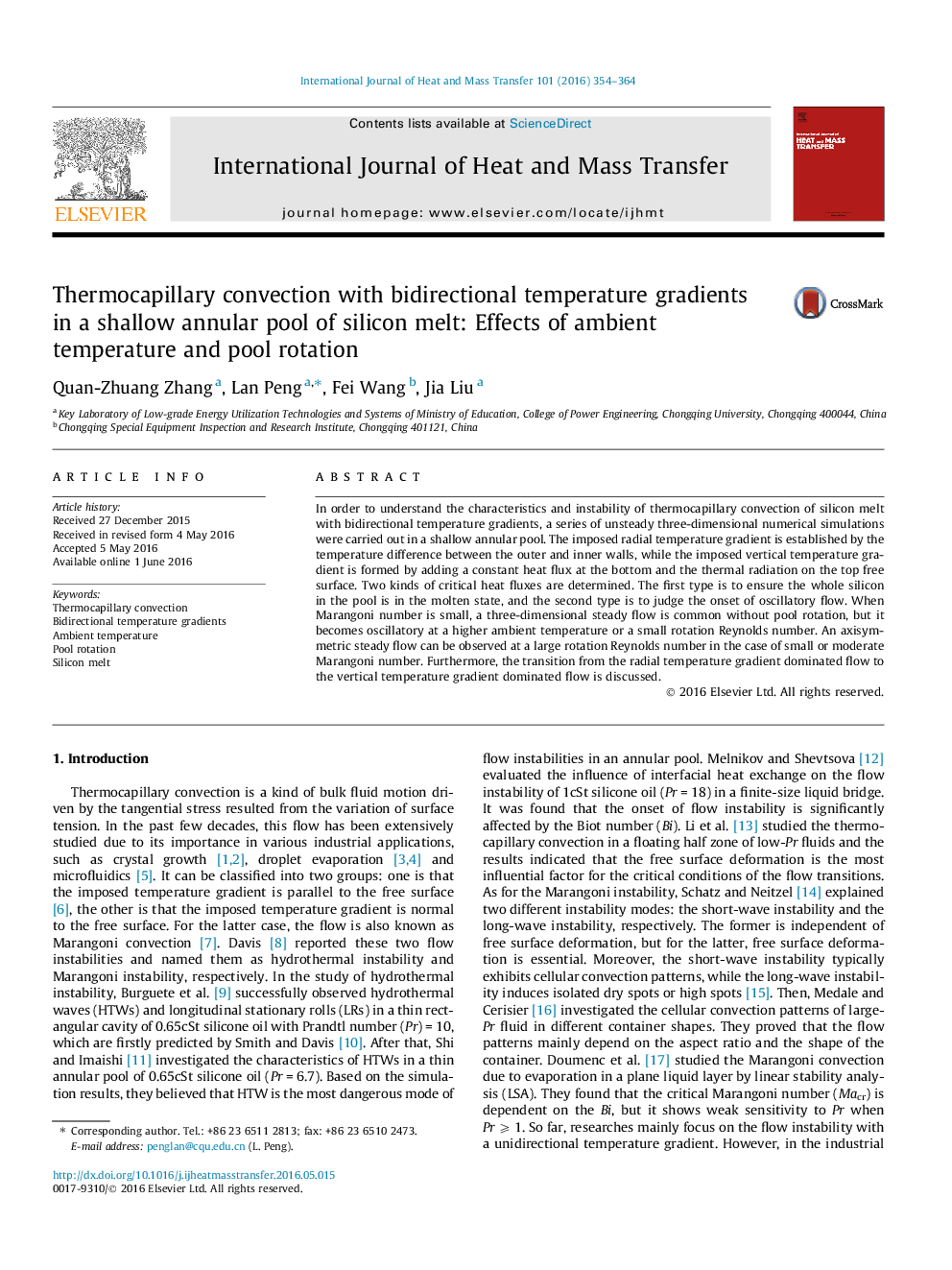| کد مقاله | کد نشریه | سال انتشار | مقاله انگلیسی | نسخه تمام متن |
|---|---|---|---|---|
| 7055245 | 1458041 | 2016 | 11 صفحه PDF | دانلود رایگان |
عنوان انگلیسی مقاله ISI
Thermocapillary convection with bidirectional temperature gradients in a shallow annular pool of silicon melt: Effects of ambient temperature and pool rotation
ترجمه فارسی عنوان
جابجایی ترموکاپیلاسی با شیب درجه حرارت دو طرفه در یک بلوک حلقه کم عمق سیلیکا ذوب: اثر دمای محیط و چرخش استخر
دانلود مقاله + سفارش ترجمه
دانلود مقاله ISI انگلیسی
رایگان برای ایرانیان
کلمات کلیدی
جابجایی ترموکاپیلا، شیب درجه حرارت دو طرفه، دمای محیط، چرخش استریو، ذوب سیلیس،
ترجمه چکیده
به منظور درک ویژگی ها و بی ثباتی حرارتی ترموکاپیلاکی از ذوب سیلیکون با شیب درجه حرارت دو طرفه، یک سری از شبیه سازی های عددی سه بعدی ناپایدار در یک استخر کم عمق انجام شد. گرادیان شعاعی اعمال شده توسط تفاوت دما بین دیواره های بیرونی و درونی تعیین می شود، در حالی که گرادیان درجه حرارت عمودی اعمال شده با افزودن شار حرارت ثابت در پایین و تابش حرارتی در سطح آزاد بالا تشکیل می شود. دو نوع جریان شار حرارتی تعیین می شود. نوع اول این است که اطمینان حاصل شود کل سیلیکون در استخر در حالت مذاب است و نوع دوم قضاوت برای شروع جریان نوسان است. هنگامی که تعداد مارانگونی کوچک است، یک جریان ثابت سه بعدی معمول است بدون چرخش استاتیک، اما در دمای بالاتر یا دمای رینولدز کوچکتر نوسان می کند. یک جریان پایدار محوری را می توان در تعداد زیادی رینولدز چرخشی مشاهده کرد که در مورد تعداد مارانگونی کوچک یا متوسط وجود دارد. علاوه بر این، انتقال از گرادیان درجه شعاعی جریان غالب به گرادیان درجه حرارت عمودی جریان غالب بحث شده است.
موضوعات مرتبط
مهندسی و علوم پایه
مهندسی شیمی
جریان سیال و فرایندهای انتقال
چکیده انگلیسی
In order to understand the characteristics and instability of thermocapillary convection of silicon melt with bidirectional temperature gradients, a series of unsteady three-dimensional numerical simulations were carried out in a shallow annular pool. The imposed radial temperature gradient is established by the temperature difference between the outer and inner walls, while the imposed vertical temperature gradient is formed by adding a constant heat flux at the bottom and the thermal radiation on the top free surface. Two kinds of critical heat fluxes are determined. The first type is to ensure the whole silicon in the pool is in the molten state, and the second type is to judge the onset of oscillatory flow. When Marangoni number is small, a three-dimensional steady flow is common without pool rotation, but it becomes oscillatory at a higher ambient temperature or a small rotation Reynolds number. An axisymmetric steady flow can be observed at a large rotation Reynolds number in the case of small or moderate Marangoni number. Furthermore, the transition from the radial temperature gradient dominated flow to the vertical temperature gradient dominated flow is discussed.
ناشر
Database: Elsevier - ScienceDirect (ساینس دایرکت)
Journal: International Journal of Heat and Mass Transfer - Volume 101, October 2016, Pages 354-364
Journal: International Journal of Heat and Mass Transfer - Volume 101, October 2016, Pages 354-364
نویسندگان
Quan-Zhuang Zhang, Lan Peng, Fei Wang, Jia Liu,
